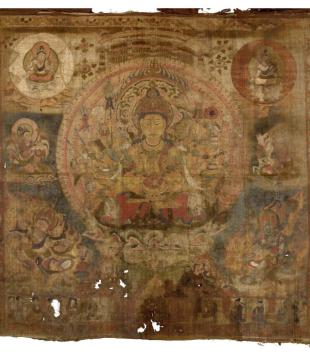MAVCOR began publishing Conversations: An Online Journal of the Center for the Study of Material and Visual Cultures of Religion in 2014. In 2017 we selected a new name, MAVCOR Journal. Articles published prior to 2017 are considered part of Conversations and are listed as such under Volumes in the MAVCOR Journal menu.
Conversations: An Online Journal of the Center for the Study of Material and Visual Cultures of Religion
 The Chapel of Our Lord of the Miracles (La Capilla de Nuestro Señor de los Milagros), San Antonio, Texas
The Chapel of Our Lord of the Miracles (La Capilla de Nuestro Señor de los Milagros), San Antonio, Texas
No exact date is known for the founding in San Antonio, Texas, of the Capilla de Nuestro Señor de los Milagros (Chapel of the Lord of Miracles), or Capilla de los Milagros, as it is sometimes called. Visitors to the shrine and its central Christ image offer both their orations and material expressions of prayer.
 Opening Virgin (Vierge Ouvrante)
Opening Virgin (Vierge Ouvrante)
This object is an example of a type of small-scale Christian moveable-part medieval sculpture called a Vierge Ouvrante (“Opening Virgin”).
 Traveling Image of the Holy Child of Atocha (Santo Niño de Atocha), Plateros, Mexico
Traveling Image of the Holy Child of Atocha (Santo Niño de Atocha), Plateros, Mexico
Each year, certain special religious images are ceremonially brought from Mexico and Central America to visit Catholic devotional communities in Southern California. These devotional statues of Catholic saints are “imágenes peregrinas,” pilgrim or traveling images.
 Arthur B. Davies, Sacramental Trees
Arthur B. Davies, Sacramental Trees
Two maidens, one bright and one shadowy, lead an ox through a curiously dense, shallow, and cubistically-fragmented woodland, heading (one presumes) through the titular sacramental trees and towards an uncertain destination.
 Drain-spout in the Form of a Flying Celestial Figure
Drain-spout in the Form of a Flying Celestial Figure
Hovering above the central courtyard of a Hindu monastery at the rural central-Indian village of Chandrehe was once a set of finely sculpted flying celestials, known within their original, tenth-century context as gandharvas, heavenly singers in the court of the gods, or vidya-dharas, meaning “carriers of truth.”
 Thousand-armed and Thousand-eyed Avalokiteshvara
Thousand-armed and Thousand-eyed Avalokiteshvara
Avalokiteshvara, one of the most important bodhisattvas in Buddhism, was popularly known as the “perceiver of the world’s cries.” Bodhisattvas, meaning literally “enlightened beings,” were devoted, out of a deep sense of compassion, to aiding other sentient beings in their quest for enlightenment, even to the point of postponing their own entry into nirvana.
 The Vincent and Mary Markham Monument
The Vincent and Mary Markham Monument
In the summer of 1900, Denver acquired an unusual sculpture to mark the last resting place of pioneer attorney Vincent Daniel Markham (1826-1895) and his wife Mary (ca. 1834-1893).
 Cuzco Miter
Cuzco Miter
The Cathedral of Cuzco, Peru holds several liturgical ornaments from the Spanish colonial period in its treasury. Among them is a magnificent embroidered miter, the headdress worn by bishops for blessings, baptisms, and processions.
 Kwame "Almighty" Akoto, The Supernatural Eyes of God
Kwame "Almighty" Akoto, The Supernatural Eyes of God
During a trip to Ghana in May 2010, I visited the roadside shop and atelier of painter Kwame Akoto, alias “Almighty,” a name he adopted so as to praise the power of God.
 Rightly Dividing the Word of Truth
Rightly Dividing the Word of Truth
Clarence Larkin’s dispensationalist chart “Rightly Dividing the Word of Truth” (1920) offers a detailed schematic of biblical history. The artistic product of an individual with experience in mechanical draftsmanship, Larkin’s chart shows how events and epochs fit together like parts in a salvation machine.
Icons move. They cross national borders and traditional boundaries. They show up in the least expected places.
 Ancestor portraits at Mogao Cave 231
Ancestor portraits at Mogao Cave 231
The integration of “secular” figures into a Buddhist cave complicates the separation established by both medieval Chinese authors and modern scholars of Buddhist art between practices of familial commemoration and religious devotion.